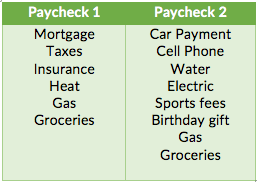Plan Your Paycheck
- November 12, 2018
Your paycheck is a starting point for making a budget. Set aside 15 minutes to review your income and expenses. This way you can plan your paycheck.
For This activity, make sure you have the following items:
- Time: 15 min
- Tools: Printable Calendar, Pen, List of Income and Expenses
Step 1: Establish Your Starting Point
Begin by telling your money what to do. Write down how much money you currently have and what you want that money to do, before your next paycheck. I want my money to ___________ before my next payday. This is your starting point. Now let’s take it further.
Step 2: Plan out our Month
Put it on a calendar
Print a calendar and highlight your paydays. Note how much money you are expecting to receive on each payday. Then go back to your list and write out all of your expenses as well as the date they are due.
Match your expenses with the corresponding pay
Put it down on paper. Write out which paycheck is going to cover each expense. If you have 2 paychecks coming into the household, use a table with 2 columns. The goal is to assign expenses to each payday check. For example:

Step 3: Repeat
Now that you have a plan for your paychecks, you can continue to repeat this process. As you go you will feel more empowered and feel greater peace of mind.
Step 4: Give Extra Money a Purpose
If all of your bills are planned for and there’s extra money left over that’s great. Give that money a purpose. Here’s just a few ways you can put your extra income to work:
- Open a savings accountsavings account for a designated purchase.
- Make an extra payment on your debt.
- Save for periodic expenses that are on the horizon, such as a birthday, anniversary, sports fees or back to school expensesback to school expenses.
- Contribute to your retirement accountretirement account.
That’s it! By following these steps each month, you’ll have a better picture of where your money is going and when to anticipate bills and other expenses.

For personalized financial guidance, reach out to GreenPath and enhance your financial planning journey.
Additional Tips:
Set a limit for discretionary spending
Discretionary spending is the amount of money you spend on non-essential purchases. These are things like entertainment, meals at restaurants, gifts, toys and other purchases.
Most people are surprised at how much money they spend on non-essential items. Set aside funds to cover your high priority bills first. Allocate a reasonable amount of money for miscellaneous purchases, such as dining out and entertainment.
Move your payment dates so that they work for you
Do you prefer to have your bills all due at the time to make it easier to plan for expenses? Or do you want to spread your bills out so you aren’t taking as a big a hit at the same time? Setup your payment dates to make them work for you.
If you can’t pay your bills, ask for help
If you can’t pay your bills, it’s best to ask for help as soon as possible. Contact GreenPath Financial Wellness today at 833-218-3541 for a free financial counseling session and see if you could benefit from a debt management plan.

Dusti Young (She/Her)
Dusti Young has a passion and energy for spreading financial wellness. Through her former role at GreenPath, she connected people to financial wellness by working with GreenPath’s partners.

GreenPath is a trusted, national nonprofit that has helped more than 65,000 households eliminate more than $200 million in debt since 1961. Call today.
Client Testimonial
“I had a good experience with GreenPath. It was an easy process to get started. They were also flexible and they gave me a plan that I was comfortable with, so it was a good thing.”

Carol | Oklahoma City, OK via ConsumerAffairs.com
Free Financial Education from GreenPath's LearningLab
Free Financial Education from GreenPath's LearningLab+
GreenPath Counseling Hours
Call 800-550-1961 for immediate help. Or request a call from a counselor at a more convenient time.
Call 877-337-3399 for immediate help. Or request a call from a counselor at a more convenient time.
- Monday-Thursday 8:00 am – 10:00 pm Eastern
- Friday 8:00 am – 8:00 pm Eastern
- Saturday 9:00 am – 6:00 pm Eastern
GreenPath is a non-profit credit counseling organization. GreenPath’s goal is to offer guidance and support to individuals seeking to manage and overcome financial challenges through education, financial counseling and debt management programs. The information provided is for educational purposes only. Consulting with a licensed financial advisor and tax advisor is recommended before making any major financial decisions. GreenPath is not a debt settlement company, credit repair company, credit repair service, nor does GreenPath provide debt consolidation loans. By using this website, you acknowledge and agree that GreenPath is not responsible for any financial decisions you make based on the information provided on this site.
